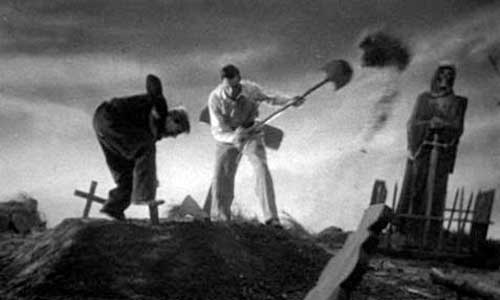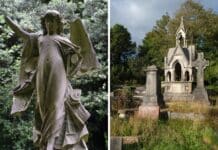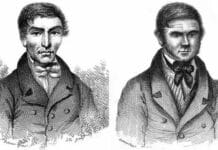Grave robbers made staying buried on the British Isles a big problem in days gone by, says NICOLA CARPENTER

“Good Frend For Iesvs Sake Forebeare, To Digg The Dvst Encloased Heare. Blese Be Ye Man Yt Spares Thes Stones, And Cvrst Be He Yt Moves My Bones.” ~ Shakespeare’s warning to potential body snatchers on his grave.
For centuries in the British Isles, staying dead and buried was a real problem. Not only did you have to worry about actually being dead when you were buried, you also had the worry of being dug up before landing on the dissection slab.
History of Grave Robbers
The first recorded history of grave robbery or ‘body snatching’ was recorded during the rule of Henry VIII, when a law was passed in 1540 by King Henry himself that gave the Company of Barbers and Surgeons the rights to the bodies of four executed criminals per year. Of course supply did not meet demand, there was a niche in the market for fresh corpses and the industrious were around to fill it.
In 1752 English judges were given the ability to decide the fate of the bodies of executed criminals and by 1831 around 11 corpses or cadavers were available for legal dissection. With hundreds studying anatomy at that time there simply were not enough dead criminals to go around.
The stealing of a corpse was a misdemeanour in English law, which carried a fine and/or short term in prison, not a felony which carried far stiffer sentences such as transportation or even death. Most body snatchers were careful only to remove the body from the grave, leaving the dead person’s clothing and jewellery untouched. Steal so much as a shirt or boot and you were for the gallows.
With the likelihood that you would not be left to rest in peace increasing, several ways to prevent body snatching where incorporated.
Some families and loved ones would sit at the grave side or employ others to do so, which wasn’t always effective, as who wants to sit around in a graveyard in the dead of night when they could be elsewhere?
Many guards left their station for the vastly more inviting tavern down the street.
Lead coffins were used as well as iron bars and cages fitted across the grave site. These methods were just as effective as the dishonest guards.
The body snatchers simply changed tactics, digging a small tunnel into the grave from outside the iron cage and dragging the body out, in some cases even taking the coffin to be melted down for scrap.
Some, like Henry Trigg a wealthy grocer of Stevenage, went to great lengths to foil the body snatchers.
Local legend has it that one night, Henry the worse for wear whilst making his way home passed by the local churchyard where noises could be heard and flickering lights seen.
Upon closer inspection over the church wall Henry was aghast to see a group of body snatchers hard at work relieving a recently buried corpse from it’s grave. Henry was determined that he would not befall the same fate.
On his death in 1724 his will gave specific instructions that his remains were to be sealed in a coffin and placed in the ’hovel’ of his brother Rev Thomas Trigg.
In carrying out his brother’s final wish Thomas would inherit all of Henry’s worldly goods.
In refusing the coffin, the inheritance would then be passed down the line and so on and so on. Henry’s remains were duly sealed in his coffin and placed in the rafters of a barn at 37 High Street, Old Stevenage.
Over the years Henry’s coffin became a tourist attraction and slowly, piece by piece Henry’s remains were removed from their resting place by ghoulish souvenir hunters. It seems Henry’s worst fear was realised.
Eventually in 1832 the Anatomy Act was passed in an effort to steam the flow of illegal corpses into the hospitals of London and other cities around Britain. This made all ‘unclaimed’ bodies available for study and dissection. An ‘unclaimed’ body could be that of a poor person who had the misfortune to die in the workhouse.
Another reason these places were avoided at all cost. However body snatching was a lucrative business.
So much so that some body snatchers didn’t even wait for their victims to die, they just hurried the process along.
We’ve all heard the story of Burke and Hare of Edinburgh, who found murder to be far more profitable and less laborious work.
But what of the ‘London Burkers’ (murder to sell a corpse for dissection) John Bishop and Thomas Williams.
Bishop and Williams were part of a gang of ’resurrection men’ who operated in Bethnal Green along with Michael Shields and James May or Black-eyed Jack as he was better known.
Throughout a twelve year career in resurrecting the dead from their graves, the gang had stolen and sold around 500-1000 fresh corpses to places of study such as St Bartholomew’s Hospital, St Thomas’ Hospital and King’s College.
It was upon reading of the exploits of Burke and Hare that Bishop and Williams decided to branch out into murder. Their business enterprise came to an end on 5th November 1831 when Bishop and Williams were arrested for the murder of a 14 year old Lincolnshire boy. They were found guilty and sentenced to hang on Monday 4th December 1831.
The day before their execution Bishop and Williams visited the prison chapel and confessed to a further three murders, Francis Pigburn and her child and a boy named Cunningham.
Each was murdered in the same way, lodgings for the night at No 2 Nova Scotia Gardens were promised before the victims were drugged with a mixture of beer, rum and laudanum.
Once the victims had slipped into unconsciousness they were pitched head first into the well at the bottom of the garden, with ropes attached to their feet for easy retrieval.
After their execution Bishops body was sent to King’s college and Williams’ to the Theatre of Anatomy, Windmill Street Haymarket for dissection. Their remains were then put on public display and No 2 Nova Scotia Gardens opened for tours at 5 shillings per person.
Burking wasn’t just a male pastime, on 8th January 1832 Elizabeth Ross was hung for the burking of Caroline Walsh. Maybe it was the fates of Burke and Hare, Bishop and Williams or Elizabeth Ross that finally put the body snatchers off their ill gotten gains as reports of grave robbing dropped dramatically after 1832.
So we can now all rest in peace, or can we?
For more creepy topics from Berkshire’s NICOLA CARPENTER, you can read her blog here.







